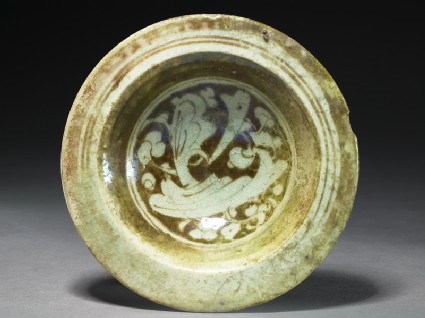Browse: 2204 objects
Dish with vegetal or epigraphic decoration
-
Details
- Associated place
- Date
- late 12th century - 1st half of the 13th century
- Material and technique
- fritware, with overglaze painting in lustre
- Dimensions
-
4.5 cm (height)
16 cm (diameter)
- Material index
- Technique index
- Object type index
- No. of items
- 1
- Credit line
- Presented by Sir Frank Brangwyn, 1950.
- Accession no.
- EAX.3068
-
Further reading
Allan, James W., Islamic Ceramics, Ashmolean-Christie's Handbooks (Oxford: Ashmolean Museum, 1991), no. 24 on p. 40, illus. p. 41
Glossary (2)
fritware, lustre
-
fritware
Ceramic material composed of ground quartz and small quantities of clay and finely ground frit (frit is obtained by pouring molten glass into water).
-
lustre
Metallic sheen obtained by applying a mixture of metallic oxides onto an already glazed ceramic that is refired at a reduced atmosphere.
Location
Objects are sometimes moved to a different location. Our object location data is usually updated on a monthly basis. Contact the Jameel Study Centre if you are planning to visit the museum to see a particular object on display, or would like to arrange an appointment to see an object in our reserve collections.
Galleries
Publications online
-

Islamic Ceramics
The precise origins of the medieval Syrian lustre industry are uncertain, though it probably derives from the Fatimid Egyptian tradition. One school, associated with Tell Minis in northern Syria, is often characterised by figural designs; that associated with the city of Raqqa on the Euphrates, of which the two opposite are examples, tends towards vegetal patterns or calligraphy. In the latter case the lustre is often rather chocolate in tone. On these two bowls, the artists (or perhaps artist?) have taken the Arabic word al-surr, ‘happiness’ and, combining brush strokes and imagination, have created two very similar, bold designs, each of which strongly suggests a peacock. The contrast between the two is quite marked, however, the one [EA1978.2175] being tightly controlled and static in impact, the other [EAX.3068] far more fluid and fluent, almost with a life of its own.
© 2013 University of Oxford - Ashmolean Museum







